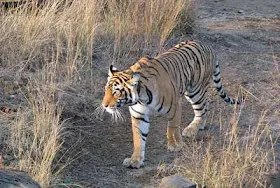For the record, "habitat" means the area and environment where the tiger lives.
At 2011, the Bengal tiger is found in these countries:
- India,
- Nepal,
- Bhutan,
- Bangladesh.
View Bengal Tiger Reserves India in a larger map
See a page on the Bengal tiger reserves of India.
In order to show the Bengal tiger habitat I have selected two reserves and Bhutan. Bhutan is different because the Bengal tiger has retired there to a safe haven at high altitude and the environment there is somewhat different to that of the reserves. One reserve that is also not typical is the Sunderbans (also spelled "Sudarbans). This is an area of sea water mangrove swamps to which the tiger has become adapted.
Sunderbans National Park and Tiger Reserve
As mentioned this park is made up of mangrove swamps. Here are two pictures of a Bengal tiger in the Sunderbans Tiger Reserve swimming across a river or esturary. The pictures are by Nikhil Devasar and courtesy the Sunderbans National Park website.
 |
| Bengal in its habitat in Sunderbans National Park - Photo: Nikhil Devasar |
 |
| Bengal in its habitat in Sunderbans National Park - Photo: Nikhil Devasar |
Bhutan
Area in world:
In Bhutan, the Bengal tiger has been photographed at 4,000 feet above sea level. This is the highest at which this subpecies of tiger has been found. What is the habitat like in the area? These pictures show us:
 |
| Bhutan Forest - picture: RAO Online |
 |
| Tiger in Bhutan - still from BBC video. |
See also: Tigers of Bhutan for a critique.
Ranthambore National Park
This is one of the major tiger reserves of India and relatively close to the capital, Delhi. This is what the Bengal tiger habitat looks like in the park:
 |
| Ranthambore National Park and tiger reserve - Photo by d.e.v.e.s.h |
 |
| Ranthambore National Park and tiger reserve - Photo by d.e.v.e.s.h |
Ranthambore is 1,334 sq km in size. The habitat is described as "dry thorn forests". You can also see grasslands at Ranthambore.
Habitat Selection
Bengal tiger habitat is selected by the tiger on the basis of suitable prey available and its density in any particular place. The tiger needs large prey to survive. Certain habitats support certain prey and in the tiger food chain the tiger prey is both herbivores and carnivores although large herbivores are primary prey. The tiger will eat anything but its main diet is wild pigs and deer of various kinds.
See also Bengal Tiger Habitat, an earlier page.

ليست هناك تعليقات:
إرسال تعليق
Your comments are always welcome.